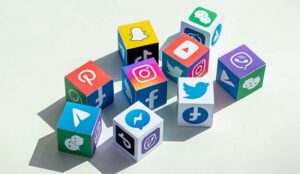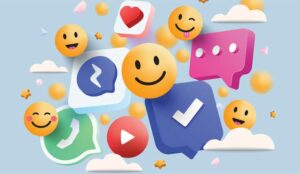Social media is big business these days. 4.70 billion people around the world now use social media, 227 million new users have come online within the last 12 months. The average daily time spent using social media is 2h 29m. But which is best for delivering customer service?
Over the last year Facebook has grown to more than 2,936 million users worldwide.
Facebook Page
Facebook Pages are one way to deliver customer service in Facebook. They allow customers or fans of a brand to ‘like’ a page, which will then send future updates to that user’s Facebook news feed. Customer support systems can also be incorporated into pages. Last year, online customer service specialists Get Satisfaction developed the Facebook Social Engagement Hub, which allows companies to answer questions posed by their customers and Facebook fans on their page.
In this sense, Facebook pages allow companies to host FAQs and interactive responses. Because of the way Facebook content is shared, customer service is likely to be less about monitoring what others are saying and trying to intervene when customers vent frustration at other methods of service, unlike Twitter.
Social customer service
Facebook could also be a great platform for social customer service, in which customers assist each other to resolve issues rather than contacting the company or service provider directly. Technology companies such as Microsoft often use this on their websites, which host large communities of users who share and discuss problems in forums.
A Facebook group could perform a similar role for companies experimenting with social customer service. Groups are similar to pages, but with a focus on community. They are useful for communications between lots of different people, all sharing information and advice. For example, in a Facebook group, a few customer service agents could answer questions from customers, or customers who were particularly adept and enthusiastic about a product could share their knowledge.
Not all products and companies are suited to social customer service. For those that are, Facebook is an increasingly useful platform.
YouTube
Companies are doing great self-service with YouTube.
Domestic heating appliance manufacturer Worcester has a series of YouTube videos showing how to perform a range of maintenance tasks, including “How to remove the Greenstar i boiler casing”. This a quick video filmed by a camera phone, proving that creating useful content doesn’t have to cost a lot of money.
Instagram is quickly becoming a preferred social platform for companies to engage consumers with its global reach and a growing audience of more than a billion users. It is the community through which people can explore, discover, connect, and buy.
In fact, 90 percent of its users follow a business, and 50 percent are more interested in a brand when they see ads for it on Instagram.
With so much opportunity to create deeper relationships with customers, companies need to be responsive and establish personal connections in a way that builds trust and earns loyalty.
Thanks to Genesys
Why Instagram for Customer Service
The popularity of Instagram is apparent among younger generations – an audience that uses the app daily. By being present where customers already are, brands can leverage the app to provide a Full Circle Customer Experience – from product exploration to customer support.
With new features added regularly, Instagram has become a Preferred Channel for discovering new products or services and shopping online. However, as customers browse your offers and dig into your brand, it’s important to be available at hand in case their experience takes a turn.
What happens when the product they ordered off your Instagram profile hasn’t arrived? Or worse, it arrived damaged. Perhaps the size needs to be changed or the customer wants your recommendation before tapping the pay button on their banking app.
It’s moments like these that brands need to be ready for. And the best way to be there when a customer needs you most is to be available to chat on the app they’re already using.
With thanks to Infobip
TikTok
With curated content from platforms like Instagram and TikTok at their fingertips, consumers have come to expect that brands understand them and are paying attention to their likes and dislikes. Tailored experiences that show a company is listening are being rewarded with brand loyalty and advocacy.
When consumers feel they’ve had a personalized experience, more than 80% said they would purchase additional items, recommend the company to a friend, and purchase repeat items — an increase of 10% from 2017.
Thanks to Genesys
Twitter now has more than 190 million users worldwide, and companies have begun to realise the possibilities it offers for customer service. Twitter is all about instant, snappy communication in messages. Used effectively, it can be faster and cheaper than telephone or email customer service.
Some call centres train customer service call handlers to also communicate using Twitter and email. The job role of traditional telephone-based agents is evolving to include social media communication. But such communication is more complex than a simple one-to-one phone call. Many people can see and interact in a Twitter conversation. Call centres may need specialised social media strategies and staff to implement and monitor them.
Proactive customer service
Perhaps the best customer service feature of Twitter is the ability for companies to monitor exactly what people are saying about their brands. By using any of a range of simple tools, companies can monitor search terms and hashtags – the Twitter term for a word preceded by the # symbol, a command which links a post to all others containing that particular hashtagged term.
You can search to see what people are saying about you at Explore
By combining a few searches – for example, the company name, product names, advertising slogans – every mention of that company on Twitter can be found, noted and acted upon if necessary.
This allows customer service to become proactive. If someone is complaining about your product or support service on Twitter, why not intervene with a message that takes ownership of the problem?
Potential PR disasters
The nature of Twitter makes it very easy to identify customers who may need service. But it also means that a customer gripe can become a public relations disaster if it isn’t dealt with correctly. It is important to know how to use any social media platform correctly before including it in a customer service strategy.
Take the example of Mars-owned confectionery brand Skittles, which redirected its web homepage to show Twitter search results for the brand name. Unfortunately they didn’t count on mischievous tweeters posting lots of negative and fake tweets about Skittles, such as ‘Skittles got stuck in my mouth whilst I was driving, forced me to slam into orphanage, killing hundreds. I’ll never eat them again’.
Disasters aside, companies such as Starbucks, Dell and BT use Twitter monitoring to engage with customers and nip complaints in the bud before they circulate widely. They are also reinforcing a positive brand image.
The best company Twitter accounts are helpful, thoughtful and develop their own style and personality. They adopt a business-like tone, but mix it with a more personal voice when suitable. They will announce new products, respond to enquiries and launch special offers, but also share staff recommendations, tips, or interesting links.
Use Twitter wisely
Twitter is also great for advertising and marketing, but it is important not to produce spam or mislead users. Don’t direct sell to people. It won’t work. Instead use it to show how good your company is, how it listens to customers and interacts with other companies. A good Twitter profile holds proper conversations with followers, and re-tweets interesting things said by others. It is a great opportunity to show a human side to a company.
In its current form, Twitter can’t be used to completely resolve customer service issues. Instead it is best when used to redirect customers to the correct email address or service telephone line, or for chasing up a problem that is already being worked upon and reassuring the customer.
Not big in terms of global usage but especially for us at Call Centre Helper a key one for listening to our audience.
LinkedIn Company Page
We share the latest news and articles from the website
LinkedIn Groups
Replacing our traditional forum.
And the winner is…
Ultimately the best social network for customer service will depend upon the product and company. As networks grow, and others spring up alongside them, companies may find they need a presence across each social media platform.
Social media is used by massive numbers of people each day, and not just young people.
Perhaps the question is not which network is best, but instead, can businesses afford to miss out on the potential benefits of social media?
Thanks to Matthew Brown
Author: Jo Robinson
Published On: 26th Jan 2011 - Last modified: 12th Nov 2024
Read more about - Call Centre Management, Customer Service, CX, Genesys, Social Media






































Hello Matthew,
You have not mentioned LinkedIn in your article – is this deliberate or an oversight? It seems that that social network may be at least as effective as Twitter or Facebook for B2B interactions?
I’d appreciate your feedback.
Hi Mathew. I enjoyed your post. Twitter and Facebook compliment each other well as part of a CRM solution. Businesses no longer question the necessity of social media for CRM solutions.
Dick
I think that LinkedIn probably applies for for business to business marketing than it does for customer service.
I would imagine as the groups become more open there it will be likely that customer service issues would start to come up on these.
I agree with Jonty’s comments about LinkedIn currently being used more for B2B rather than customer service, however it should still be considered as part of the whole social media package that companies use as part of their marketing strategy.
In reply to Dick, this is a look at Facebook and Twitter in particular and LinkedIn’s omission was deliberate – as Jonty said, at the moment LinkedIn seems to have more relevance for B2B marketing than customer service.
Of course, that could change, and if we were to extend this to all social media platforms a few more would be included along with LinkedIn. It will be interesting to see how businesses use LinkedIn and the upcoming social networks over time.